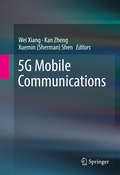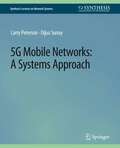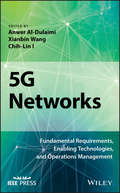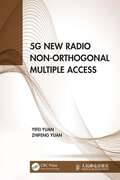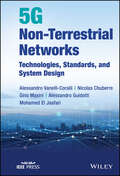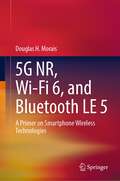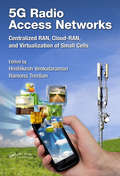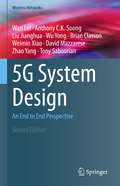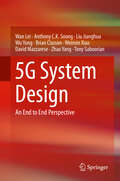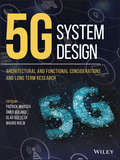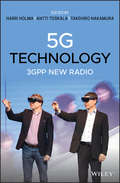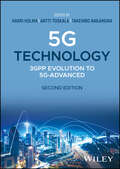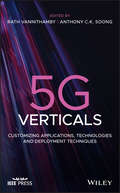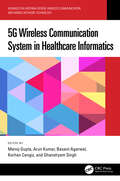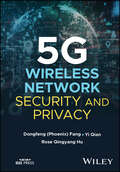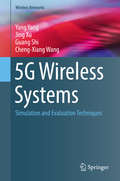- Table View
- List View
5G Mobile Communications
by Wei Xiang Kan Zheng Xuemin Sherman ShenThis book provides a comprehensive overview of the emerging technologies for next-generation 5G mobile communications, with insights into the long-term future of 5G. Written by international leading experts on the subject, this contributed volume covers a wide range of technologies, research results, and networking methods. Key enabling technologies for 5G systems include, but are not limited to, millimeter-wave communications, massive MIMO technology and non-orthogonal multiple access.5G will herald an even greater rise in the prominence of mobile access based upon both human-centric and machine-centric networks. Compared with existing 4G communications systems, unprecedented numbers of smart and heterogeneous wireless devices will be accessing future 5G mobile systems. As a result, a new paradigm shift is required to deal with challenges on explosively growing requirements in mobile data traffic volume (1000x), number of connected devices (10–100x), typical end-user data rate (10–100x), and device/network lifetime (10x). Achieving these ambitious goals calls for revolutionary candidate technologies in future 5G mobile systems. Designed for researchers and professionals involved with networks and communication systems, 5G Mobile Communications is a straightforward, easy-to-read analysis of the possibilities of 5G systems.
5G Mobile Networks: A Systems Approach (Synthesis Lectures on Network Systems)
by Larry PetersonThis book describes the 5G mobile network from a systems perspective, focusing on the fundamental design principles that are easily obscured by an overwhelming number of acronyms and standards definitions that dominate this space. The book is written for system generalists with the goal of helping bring up to speed a community that understands a broad range of systems issues (but knows little or nothing about the cellular network) so it can play a role in the network's evolution. This is a community that understands both feature velocity and best practices in building robust scalable systems, and so it has an important role to play in bringing to fruition all of 5G's potential. In addition to giving a step-by-step tour of the design rationale behind 5G, the book aggressively disaggregates the 5G mobile network. Building a disaggregated, virtualized, and software-defined 5G access network is the direction the industry is already headed (for good technical and business reasons), but breaking the 5G network down into its elemental components is also the best way to explain how 5G works. It also helps to illustrate how 5G might evolve in the future to provide even more value. An open source implementation of 5G serves as the technical underpinning for the book. The authors, in collaboration with industrial and academic partners, are working towards a cloud-based implementation that takes advantage of both Software-Defined Networking (SDN) and cloud-native (microservice-based) architectures, culminating in a managed 5G-enabled EdgeCloud-as-a-Service built on the components and mechanisms described throughout the book.
5G Networks: Fundamental Requirements, Enabling Technologies, and Operations Management (Ieee Press Series On Vehicular Technology Ser.)
by Anwer Al-Dulaimi Xianbin Wang Chih-Lin IA reliable and focused treatment of the emergent technology of fifth generation (5G) networks This book provides an understanding of the most recent developments in 5G, from both theoretical and industrial perspectives. It identifies and discusses technical challenges and recent results related to improving capacity and spectral efficiency on the radio interface side, and operations management on the core network side. It covers both existing network technologies and those currently in development in three major areas of 5G: spectrum extension, spatial spectrum utilization, and core network and network topology management. It explores new spectrum opportunities; the capability of radio access technology; and the operation of network infrastructure and heterogeneous QoE provisioning. 5G Networks: Fundamental Requirements, Enabling Technologies, and Operations Management is split into five sections: Physical Layer for 5G Radio Interface Technologies; Radio Access Technology for 5G Networks; 5G Network Interworking and Core Network Advancements; Vertical 5G Applications; and R&D and 5G Standardization. It starts by introducing emerging technologies in 5G software, hardware, and management aspects before moving on to cover waveform design for 5G and beyond; code design for multi-user MIMO; network slicing for 5G networks; machine type communication in the 5G era; provisioning unlicensed LAA interface for smart grid applications; moving toward all-IT 5G end-to-end infrastructure; and more. This valuable resource: Provides a comprehensive reference for all layers of 5G networks Focuses on fundamental issues in an easy language that is understandable by a wide audience Includes both beginner and advanced examples at the end of each section Features sections on major open research challenges 5G Networks: Fundamental Requirements, Enabling Technologies, and Operations Management is an excellent book for graduate students, academic researchers, and industry professionals, involved in 5G technology.
5G Networks: Fundamental Requirements, Enabling Technologies, and Operations Management
by Anwer Al-Dulaimi Xianbin Wang I. Chih-LinA reliable and focused treatment of the emergent technology of fifth generation (5G) networks This book provides an understanding of the most recent developments in 5G, from both theoretical and industrial perspectives. It identifies and discusses technical challenges and recent results related to improving capacity and spectral efficiency on the radio interface side, and operations management on the core network side. It covers both existing network technologies and those currently in development in three major areas of 5G: spectrum extension, spatial spectrum utilization, and core network and network topology management. It explores new spectrum opportunities; the capability of radio access technology; and the operation of network infrastructure and heterogeneous QoE provisioning. 5G Networks: Fundamental Requirements, Enabling Technologies, and Operations Management is split into five sections: Physical Layer for 5G Radio Interface Technologies; Radio Access Technology for 5G Networks; 5G Network Interworking and Core Network Advancements; Vertical 5G Applications; and R&D and 5G Standardization. It starts by introducing emerging technologies in 5G software, hardware, and management aspects before moving on to cover waveform design for 5G and beyond; code design for multi-user MIMO; network slicing for 5G networks; machine type communication in the 5G era; provisioning unlicensed LAA interface for smart grid applications; moving toward all-IT 5G end-to-end infrastructure; and more. This valuable resource: Provides a comprehensive reference for all layers of 5G networks Focuses on fundamental issues in an easy language that is understandable by a wide audience Includes both beginner and advanced examples at the end of each section Features sections on major open research challenges 5G Networks: Fundamental Requirements, Enabling Technologies, and Operations Management is an excellent book for graduate students, academic researchers, and industry professionals, involved in 5G technology.
5G New Radio Non-Orthogonal Multiple Access
by Yifei Yuan Zhifeng YuanThis book provides detailed descriptions of downlink non-orthogonal multiple transmissions and uplink non-orthogonal multiple access (NOMA) from the aspects of majorly used 5G new radio scenarios and system performance. For the downlink, the discussion focuses on the candidate schemes in 3GPP standards which are not only applicable to unicast services but also to broadcast/multicast scenarios. For the uplink, the main target scenario is massive machine-type communications where grant-free transmission can reduce signaling overhead, power consumption of devices and access delays. The design principles of several uplink NOMA schemes are discussed in-depth, together with the analysis of their performances and receiver complexities. Devoted to the basic technologies of NOMA and its theoretical principles, data analysis, basic algorithms, evaluation methodology and simulation results, this book will be an essential read for researchers and students of digital communications, wireless communications engineers and those who are interested in mobile communications in general.
5G New Radio Non-Orthogonal Multiple Access
by Yifei Yuan Zhifeng YuanThis book provides detailed descriptions of downlink non-orthogonal multiple transmissions and uplink non-orthogonal multiple access (NOMA) from the aspects of majorly used 5G new radio scenarios and system performance. For the downlink, the discussion focuses on the candidate schemes in 3GPP standards which are not only applicable to unicast services but also to broadcast/multicast scenarios. For the uplink, the main target scenario is massive machine-type communications where grant-free transmission can reduce signaling overhead, power consumption of devices and access delays. The design principles of several uplink NOMA schemes are discussed in-depth, together with the analysis of their performances and receiver complexities. Devoted to the basic technologies of NOMA and its theoretical principles, data analysis, basic algorithms, evaluation methodology and simulation results, this book will be an essential read for researchers and students of digital communications, wireless communications engineers and those who are interested in mobile communications in general.
5G Non-Terrestrial Networks: Technologies, Standards, and System Design
by Alessandro Vanelli-Coralli Nicolas Chuberre Gino Masini Alessandro Guidotti Mohamed El Jaafari5G Non-Terrestrial Networks Provides a complete and detailed description of the non-terrestrial component in the 5G ecosystem 5G Non-Terrestrial Networks is the first multi-authored reference dedicated to the integration of non-terrestrial networks (NTN) into the 5G ecosystem. Written by leaders in the development of the 3GPP 5G NTN specification, this authoritative resource addresses all key aspects of non-terrestrial components of 5G systems, including standardization, architecture, protocols, and regulatory considerations. Drawing from their expertise in academic and industrial research and development, the authors introduce fundamental principles of non-terrestrial communications, define the NTN architecture and radio protocol stacks, describe applications to support mobility and radio resource management, and more. The book covers 5G New Radio-based technology for NTN as well as LTE NB-IoT/eMTC, providing a well-rounded understanding of the unique characteristics of 5G-NTN systems. Throughout the text, the authors offer insights on various design approaches, technical choices, and trade-off options. In addition, the book: Addresses the integration of non-terrestrial networks into 5G systems at all levels Describes the principles of non-terrestrial systems, including orbital parameters, link budget, propagation, and space/ground segments Includes a detailed overview of 5G-NTN system architectures, deployment scenarios, and spectrum aspects Covers NB-IoT and eMTC in NTN, NTN use cases, 5G QoS, and New Radio Discusses the potential of non-terrestrial components of 5G in the future 6G ecosystem 5G Non-Terrestrial Networks is a must-have for communication engineers, satellite network operators, aerospace and electrical engineers, network engineers, academic researchers and industry professionals involved in 5G infrastructure development, as well as advanced students taking courses on 5G and satellite communication.
5G Non-Terrestrial Networks: Technologies, Standards, and System Design
by Alessandro Vanelli-Coralli Nicolas Chuberre Gino Masini Alessandro Guidotti Mohamed El Jaafari5G Non-Terrestrial Networks Provides a complete and detailed description of the non-terrestrial component in the 5G ecosystem 5G Non-Terrestrial Networks is the first multi-authored reference dedicated to the integration of non-terrestrial networks (NTN) into the 5G ecosystem. Written by leaders in the development of the 3GPP 5G NTN specification, this authoritative resource addresses all key aspects of non-terrestrial components of 5G systems, including standardization, architecture, protocols, and regulatory considerations. Drawing from their expertise in academic and industrial research and development, the authors introduce fundamental principles of non-terrestrial communications, define the NTN architecture and radio protocol stacks, describe applications to support mobility and radio resource management, and more. The book covers 5G New Radio-based technology for NTN as well as LTE NB-IoT/eMTC, providing a well-rounded understanding of the unique characteristics of 5G-NTN systems. Throughout the text, the authors offer insights on various design approaches, technical choices, and trade-off options. In addition, the book: Addresses the integration of non-terrestrial networks into 5G systems at all levels Describes the principles of non-terrestrial systems, including orbital parameters, link budget, propagation, and space/ground segments Includes a detailed overview of 5G-NTN system architectures, deployment scenarios, and spectrum aspects Covers NB-IoT and eMTC in NTN, NTN use cases, 5G QoS, and New Radio Discusses the potential of non-terrestrial components of 5G in the future 6G ecosystem 5G Non-Terrestrial Networks is a must-have for communication engineers, satellite network operators, aerospace and electrical engineers, network engineers, academic researchers and industry professionals involved in 5G infrastructure development, as well as advanced students taking courses on 5G and satellite communication.
5G NR, Wi-Fi 6, and Bluetooth LE 5: A Primer on Smartphone Wireless Technologies
by Douglas H MoraisThis book provides, at a high level and in a tractable fashion, a description of how wireless communications are achieved in the latest smartphones. The author shows how smartphones communicate via three separate systems, namely 5G NR, Wi-Fi 6, and Bluetooth Low Energy 5. He explains how 5G NR allows mobile voice and high-speed data communication, how Wi-Fi allows smartphone attachment to the Internet independent of 5G NR, and how Bluetooth allows smartphone attachment to speakers, in-car entertainment systems, smart watches, etc. This text explains the key basic technologies employed and then addresses how each system operates. This book is of interest to anyone with a rudimentary scientific understanding who desires to know more at an intuitive level rather than rigorous one how smartphones achieve wireless communications.
5G Radio Access Networks: Centralized RAN, Cloud-RAN and Virtualization of Small Cells
by Hrishikesh Venkataraman Ramona TrestianC-RAN and virtualized Small Cell technology poses several major research challenges. These include dynamic resource allocation, self-configuration in the baseband pool, high latency in data transfer between radio unit and baseband unit, the cost of data delivery, high volume of data in the network, software networking aspects, potential energy savings, security concerns, privacy of user’s personal data at a remote place, limitations of virtualized environment, etc. This book provides deeper insights into the next generation RAN architecture and surveys the coexistence of SDN, C-RAN and Small Cells solutions proposed in the literature at different levels.
5G System Design: An End to End Perspective (Wireless Networks)
by Wan Lei Liu Jianghua Wu Yong Brian Classon Weimin Xiao David Mazzarese Zhao Yang Tony Saboorian Anthony C.K. SoongThis book presents a detailed pedagogical description of the 5G commercial wireless communication system design, from an end to end perspective, by those that were intimate with its development. The exposition only assumes that the reader is passingly familiar with LTE and builds upon that knowledge. By comparing and contrasting NR with LTE, it allows for quick mastering of 5G. As such it gives concise and highly accessible description of the key technologies in the 5G physical layer, radio access network layer protocols and procedures, how the 5G core and EPC is integrated into the radio access network, how virtualization, slicing and edge computer will fundamentally change the way we interact with the network, as well as 5G spectrum issues.The 2nd edition of this book significantly enhances and updates the first edition by adding 5G security and Release-16 developments. Loosely speaking, 5G Release-15 can be characterized as being optimized for the cellular carrier eMBB service while 5G Release-16 is the beginning of the optimization of 5G for the vertical industries. It mainly focused on the support of the vehicular vertical and Industrial Internet of Things. As such, we have significantly altered the first edition to cover the key features standardized in Release-16 including: URLLC, V2X, IIoT, enhanced MIMO, unlicensed access, positioning, power savings and IAB. On the network side, detailed discussion covers NR security as well as the newly standardized access traffic steering, non 3GPP access switching and splitting features, non 3GPP access network support and private networks.Engineers, computer scientists and professionals from those with a passing knowledge of 4G LTE to experts in the field will find this book to be a valuable asset. They will gain a comprehensive understanding of the end to end 5G commercial wireless system. Advanced-level students and researchers studying and working in communication engineering, who want to gain an understanding of the 5G system (as well as methodologies to evaluate features and technologies intended to supplement 5G) will also find this book to be a valuable resource.
5G System Design: An End to End Perspective
by Wan Lei Anthony C.K. Soong Liu Jianghua Wu Yong Brian Classon Weimin Xiao David Mazzarese Zhao Yang Tony SaboorianThis book presents a detailed pedagogical description of the 5G commercial wireless communication system design, from an end to end perspective. It compares and contrasts NR with LTE, and gives a concise and highly accessible description of the key technologies in the 5G physical layer, radio access network layer protocols and procedures. This book also illustrates how the 5G core and EPC is integrated into the radio access network, how virtualization and edge computer fundamentally change the way users interact with the network, as well as 5G spectrum issues.This book is structured into six chapters. The first chapter reviews the use cases, requirements, and standardization organization and activities for 5G. These are 5G requirements and not NR specifically, as technology that meets the requirements, may be submitted to the ITU as 5G technology. This includes a set of Radio Access Technologies (RATs), consisting of NR and LTE; with each RAT meeting different aspects of the requirements. The second chapter describes the air interface of NR and LTE side by side. The basic aspects of LTE that NR builds upon are first described, followed by sections on the NR specific technologies, such as carrier/channel, spectrum/duplexing (including SUL), LTE/NR co-existence and new physical layer technologies (including waveform, Polar/LDPC codes, MIMO, and URLLC/mMTC). In all cases the enhancements made relative to LTE are made apparent. The third chapter contains descriptions of NR procedures (IAM/Beam Management/Power control/HARQ), protocols (CP/UP/mobility, including grant-free), and RAN architecture. The fourth chapter includes a detailed discussion related to end-to-end system architecture, and the 5G Core (5GC), network slicing, service continuity, relation to EPC, network virtualization, and edge computing. The fifth and major chapter describes the ITU submission and how NR and LTE meet the 5G requirements in significant detail, from the rapporteur responsible for leading the preparation and evaluation, as well as some field trial results.Engineers, computer scientists and professionals with a passing knowledge of 4G LTE and a comprehensive understanding of the end to end 5G commercial wireless system will find this book to be a valuable asset. Advanced-level students and researchers studying and working in communication engineering, who want to gain an understanding of the 5G system (as well as methodologies to evaluate features and technologies intended to supplement 5G) will also find this book to be a valuable resource.
5G System Design: Architectural and Functional Considerations and Long Term Research
by Patrick Marsch 214 Mer Bulak 231 Olav Queseth Mauro BoldiThis book provides a comprehensive overview of the latest research and standardization progress towards the 5th generation (5G) of mobile communications technology and beyond. It covers a wide range of topics from 5G use cases and their requirements, to spectrum, 5G end-to-end (E2E) system architecture including core network (CN), transport network (TN) and radio access network (RAN) architecture, network slicing, security and network management. It further dives into the detailed functional design and the evaluation of different 5G concepts, and provides details on planned trials and pre-commercial deployments across the globe. While the book naturally captures the latest agreements in 3rd Generation Partnership Project (3GPP) New Radio (NR) Release 15, it goes significantly beyond this by describing the likely developments towards the final 5G system that will ultimately utilize a wide range of spectrum bands, address all envisioned 5G use cases, and meet or exceed the International Mobile Telecommunications (IMT) requirements for the year 2020 and beyond (IMT-2020). 5G System Design: Architectural and Functional Considerations and Long Term Research is based on the knowledge and consensus from 158 leading researchers and standardization experts from 54 companies or institutes around the globe, representing key mobile network operators, network vendors, academic institutions and regional bodies for 5G. Different from earlier books on 5G, it does not focus on single 5G technology components, but describes the full 5G system design from E2E architecture to detailed functional design, including details on 5G performance, implementation and roll-out.
5G System Design: Architectural and Functional Considerations and Long Term Research
by Patrick Marsch Ömer Bulakci Olav Queseth Mauro BoldiThis book provides a comprehensive overview of the latest research and standardization progress towards the 5th generation (5G) of mobile communications technology and beyond. It covers a wide range of topics from 5G use cases and their requirements, to spectrum, 5G end-to-end (E2E) system architecture including core network (CN), transport network (TN) and radio access network (RAN) architecture, network slicing, security and network management. It further dives into the detailed functional design and the evaluation of different 5G concepts, and provides details on planned trials and pre-commercial deployments across the globe. While the book naturally captures the latest agreements in 3rd Generation Partnership Project (3GPP) New Radio (NR) Release 15, it goes significantly beyond this by describing the likely developments towards the final 5G system that will ultimately utilize a wide range of spectrum bands, address all envisioned 5G use cases, and meet or exceed the International Mobile Telecommunications (IMT) requirements for the year 2020 and beyond (IMT-2020). 5G System Design: Architectural and Functional Considerations and Long Term Research is based on the knowledge and consensus from 158 leading researchers and standardization experts from 54 companies or institutes around the globe, representing key mobile network operators, network vendors, academic institutions and regional bodies for 5G. Different from earlier books on 5G, it does not focus on single 5G technology components, but describes the full 5G system design from E2E architecture to detailed functional design, including details on 5G performance, implementation and roll-out.
5G Technology: 3GPP New Radio
by Harri HolmaA comprehensive guide to 5G technology, applications and potential for the future 5G brings new technology solutions to the 5G mobile networks including new spectrum options, new antenna structures, new physical layer and protocols designs and new network architectures. 5G Technology: 3GPP New Radio is a comprehensive resource that offers explanations of 5G specifications, performance evaluations, aspects of device design, practical deployment considerations and illustrative examples from field experiences. With contributions from a panel of international experts on the topic, the book presents the main new technology components in 5G and describes the physical layer, radio protocols and network performance. The authors review the deployment aspects such as site density and transport network and explore the 5G performance aspects including data rates and coverage and latency. The book also contains illustrative examples of practical field measurement. In addition, the book includes the most recent developments in 4G LTE evolution and offers an outlook for the future of the evolution of 5G. This important book: Offers an introduction to 5G technology and its applications Contains contributions from international experts on the topic Reviews the main technology components in 5G Includes information on the optimisation of the Internet of things Presents illustrative examples of practical field measurements Written for students and scientists interested in 5G technology, 5G Technology: 3GPP New Radio provides a clear understanding of the underlying 5G technology that promotes the opportunity to take full benefit of new capabilities.
5G Technology: 3GPP New Radio
by Harri Holma Antti Toskala Takehiro NakamuraA comprehensive guide to 5G technology, applications and potential for the future 5G brings new technology solutions to the 5G mobile networks including new spectrum options, new antenna structures, new physical layer and protocols designs and new network architectures. 5G Technology: 3GPP New Radio is a comprehensive resource that offers explanations of 5G specifications, performance evaluations, aspects of device design, practical deployment considerations and illustrative examples from field experiences. With contributions from a panel of international experts on the topic, the book presents the main new technology components in 5G and describes the physical layer, radio protocols and network performance. The authors review the deployment aspects such as site density and transport network and explore the 5G performance aspects including data rates and coverage and latency. The book also contains illustrative examples of practical field measurement. In addition, the book includes the most recent developments in 4G LTE evolution and offers an outlook for the future of the evolution of 5G. This important book: Offers an introduction to 5G technology and its applications Contains contributions from international experts on the topic Reviews the main technology components in 5G Includes information on the optimisation of the Internet of things Presents illustrative examples of practical field measurements Written for students and scientists interested in 5G technology, 5G Technology: 3GPP New Radio provides a clear understanding of the underlying 5G technology that promotes the opportunity to take full benefit of new capabilities.
5G Technology: 3GPP Evolution to 5G-Advanced
by Harri Holma Antti Toskala Takehiro Nakamura5G TECHNOLOGY An Essential Insider’s View of the Development Work of 5G Technology Up to Release 18 5G brings new technology solutions to the 5G mobile networks, including new spectrum options, antenna structures, physical layer and protocols designs, and network architectures. 5G Technology: 3GPP Evolution to 5G-Advanced is an accessible and comprehensive resource that offers explanations of 5G specifications and performance evaluations, aspects of device design, practical deployment considerations and illustrative examples from field experiences. With contributions from a panel of international experts on the topic (industry insiders working at the forefront of development), the book presents the main new technology components in 5G and describes the physical layer, radio protocols, and network performance indicators associated with them. It has intentionally been written to cater to individuals at all levels of 5G expertise. Some of the topics of discussion and learning resources in the work include: An easy-to-understand insider’s overview of 5G from editors and authors who are actively working with the 5G development in 3GPP, the forum defining the requirements Deployment aspects, such as site density and transport network, plus exploration into 5G performance aspects, including data rates, coverage, and latency A large number of illustrations including simulation and measurement results of 5G technology performance, plus key 5G procedures Updated information on industrial IoT, radio enhancements in Releases 16 and 17, open RAN and virtualized RAN, 5G verticals and new use cases, and the 5G-Advanced development in Release 18 and outlook towards Release 19 5G Technology: 3GPP Evolution to 5G-Advanced serves as a complete resource for wireless researchers, network planners, lecturers in universities, technology analysts, R&D engineers, application developers, and spectrum regulators who wish to thoroughly understand the latest in 5G technology and get ahead of the curve with regards to its potential applications in a wide variety of industries.
5G Technology: 3GPP Evolution to 5G-Advanced
by Harri Holma Antti Toskala Takehiro Nakamura5G TECHNOLOGY An Essential Insider’s View of the Development Work of 5G Technology Up to Release 18 5G brings new technology solutions to the 5G mobile networks, including new spectrum options, antenna structures, physical layer and protocols designs, and network architectures. 5G Technology: 3GPP Evolution to 5G-Advanced is an accessible and comprehensive resource that offers explanations of 5G specifications and performance evaluations, aspects of device design, practical deployment considerations and illustrative examples from field experiences. With contributions from a panel of international experts on the topic (industry insiders working at the forefront of development), the book presents the main new technology components in 5G and describes the physical layer, radio protocols, and network performance indicators associated with them. It has intentionally been written to cater to individuals at all levels of 5G expertise. Some of the topics of discussion and learning resources in the work include: An easy-to-understand insider’s overview of 5G from editors and authors who are actively working with the 5G development in 3GPP, the forum defining the requirements Deployment aspects, such as site density and transport network, plus exploration into 5G performance aspects, including data rates, coverage, and latency A large number of illustrations including simulation and measurement results of 5G technology performance, plus key 5G procedures Updated information on industrial IoT, radio enhancements in Releases 16 and 17, open RAN and virtualized RAN, 5G verticals and new use cases, and the 5G-Advanced development in Release 18 and outlook towards Release 19 5G Technology: 3GPP Evolution to 5G-Advanced serves as a complete resource for wireless researchers, network planners, lecturers in universities, technology analysts, R&D engineers, application developers, and spectrum regulators who wish to thoroughly understand the latest in 5G technology and get ahead of the curve with regards to its potential applications in a wide variety of industries.
5G Verticals: Customizing Applications, Technologies and Deployment Techniques
by Rath Vannithamby Anthony C.K. SoongA comprehensive text to an understanding the next generation mobile broadband and wireless Internet of Things (IoT) technologies 5G Verticals brings together in one comprehensive volume a group of visionaries and technical experts from academia and industry. The expert authors discuss the applications and technologies that comprise 5G verticals. The earlier network generations (2G to 4G) were designed as on-size-fits-all, general-purpose connectivity platforms with limited differentiation capabilities. 5G networks have the capability to demand customizable mobile networks and create an ecosystem for technical and business innovation involving vertical markets such as automotive, healthcare, manufacturing, energy, food and agriculture, city management, government, public transportation, media and more. 5G will serve a large portfolio of applications with various requirements ranging from high reliability to ultra-low latency going through high bandwidth and mobility. In this book, the authors explore applications and usages of various 5G verticals including a set of key metrics for these uses and their corresponding target requirements. The book also examines the potential network architectures and enabling technologies to meet the requirements of 5G verticals. This important book: Offers a comprehensive resource to the promise of 5G Verticals Provides a set of key metrics for the uses and target requirements Contains illustrative examples of the technology and applications Includes contributions from experts in the field and professionals that developed the 5G standards Provides an analysis of specific vertical industries which have the potential to be among the first industries to use 5G Written for industry practitioners, engineers and researchers, 5G Verticals discusses the technology that enables the 5G system to be flexibly deployed and scaled.
5G Verticals: Customizing Applications, Technologies and Deployment Techniques
by Rath Vannithamby Anthony SoongA comprehensive text to an understanding the next generation mobile broadband and wireless Internet of Things (IoT) technologies 5G Verticals brings together in one comprehensive volume a group of visionaries and technical experts from academia and industry. The expert authors discuss the applications and technologies that comprise 5G verticals. The earlier network generations (2G to 4G) were designed as on-size-fits-all, general-purpose connectivity platforms with limited differentiation capabilities. 5G networks have the capability to demand customizable mobile networks and create an ecosystem for technical and business innovation involving vertical markets such as automotive, healthcare, manufacturing, energy, food and agriculture, city management, government, public transportation, media and more. 5G will serve a large portfolio of applications with various requirements ranging from high reliability to ultra-low latency going through high bandwidth and mobility. In this book, the authors explore applications and usages of various 5G verticals including a set of key metrics for these uses and their corresponding target requirements. The book also examines the potential network architectures and enabling technologies to meet the requirements of 5G verticals. This important book: Offers a comprehensive resource to the promise of 5G Verticals Provides a set of key metrics for the uses and target requirements Contains illustrative examples of the technology and applications Includes contributions from experts in the field and professionals that developed the 5G standards Provides an analysis of specific vertical industries which have the potential to be among the first industries to use 5G Written for industry practitioners, engineers and researchers, 5G Verticals discusses the technology that enables the 5G system to be flexibly deployed and scaled.
5G Wireless Communication System in Healthcare Informatics (Advances in Antenna Design, Wireless Communication and Mobile Network Technology)
by Manoj Gupta Arun Kumar Basant Agarwal Korhan Cengiz Ghanshyam SinghThis text discusses problems and needs with the implementation of a 5G mobile communications system in the healthcare sector. It covers the issues related to advanced modulation schemes, telehealth, and remote diagnosis. It discusses important topics including virtual healthcare monitoring, spectrum sensing techniques, the role of 5G in medical applications, the role of nano- communication in healthcare informatics, and remote diagnosis. The text will be useful for graduate students, academic researchers, and professionals in the fields of electrical, and electronics and communication engineering, and allied healthcare. This book; • Discusses novel architecture to manage the allocation of resources, and the interference issue among existing and advanced radios • Provides focus to estimate the performance, cost and accommodation of the next generation technology design for the IoT, modern health- care, and education • Covers advanced technologies and their role in healthcare • Discusses key topics including spectrum access, advanced waveforms, which can help in standardization of 5G based smart hospital • Explores the impact of telemedicine in smart healthcare. This reference text covers the latest advances in the field of 5G mobile communication for healthcare informatics, addressing both original algorithm development and new applications of 5G mobile Communications.
5G Wireless Communication System in Healthcare Informatics (Advances in Antenna Design, Wireless Communication and Mobile Network Technology)
by Manoj Gupta Arun Kumar Basant Aggarwal Korhan Cengiz Ghanshyam SinghThis text discusses problems and needs with the implementation of a 5G mobile communications system in the healthcare sector. It covers the issues related to advanced modulation schemes, telehealth, and remote diagnosis. It discusses important topics including virtual healthcare monitoring, spectrum sensing techniques, the role of 5G in medical applications, the role of nano- communication in healthcare informatics, and remote diagnosis. The text will be useful for graduate students, academic researchers, and professionals in the fields of electrical, and electronics and communication engineering, and allied healthcare. This book; • Discusses novel architecture to manage the allocation of resources, and the interference issue among existing and advanced radios • Provides focus to estimate the performance, cost and accommodation of the next generation technology design for the IoT, modern health- care, and education • Covers advanced technologies and their role in healthcare • Discusses key topics including spectrum access, advanced waveforms, which can help in standardization of 5G based smart hospital • Explores the impact of telemedicine in smart healthcare. This reference text covers the latest advances in the field of 5G mobile communication for healthcare informatics, addressing both original algorithm development and new applications of 5G mobile Communications.
5G Wireless Network Security and Privacy (IEEE Press)
by DongFeng Fang Yi Qian Rose Qingyang Hu5G WIRELESS NETWORK An expert presentation of 5G security, privacy, and network performance In 5G Wireless Network Security and Privacy, a team of veteran engineers delivers a robust and accessible discussion of 5G security solutions, including physical layer security, authentication, and mobility management. In the book, the authors expertly cover the requirements of 5G wireless network security and privacy, with explorations of existing solutions and vulnerabilities from security architecture and mechanism perspectives. Readers will learn how to enhance the security and network performance of 5G wireless networks in contexts like vehicle‐to‐vehicle and vehicle‐to‐infrastructure communications, industrial automation, health services, smart cities, and smart homes. They will develop a comprehensive understanding of 5G wireless network security as they move through the book’s 11 insightful chapters, developing in‐depth knowledge on the current state of 5G security and coming developments in the field. Readers will also find: A thorough introduction to legacy cellular network security, including network performance development from 1G to 4G In‐depth treatments of 5G network security, including the motivation and objectives of 5G wireless network security Comprehensive explorations of wireless security solutions, including cryptographic approaches and physical layer security Fulsome discussions of the security architecture of cellular networks, including 3G and 4G security Perfect for researchers and professionals working in the field of cybersecurity and 5G wireless networks, 5G Wireless Network Security and Privacy will also earn a place in the libraries of engineers, computer scientists, and graduate students studying 5G network security and privacy.
5G Wireless Network Security and Privacy (IEEE Press)
by DongFeng Fang Yi Qian Rose Qingyang Hu5G WIRELESS NETWORK An expert presentation of 5G security, privacy, and network performance In 5G Wireless Network Security and Privacy, a team of veteran engineers delivers a robust and accessible discussion of 5G security solutions, including physical layer security, authentication, and mobility management. In the book, the authors expertly cover the requirements of 5G wireless network security and privacy, with explorations of existing solutions and vulnerabilities from security architecture and mechanism perspectives. Readers will learn how to enhance the security and network performance of 5G wireless networks in contexts like vehicle‐to‐vehicle and vehicle‐to‐infrastructure communications, industrial automation, health services, smart cities, and smart homes. They will develop a comprehensive understanding of 5G wireless network security as they move through the book’s 11 insightful chapters, developing in‐depth knowledge on the current state of 5G security and coming developments in the field. Readers will also find: A thorough introduction to legacy cellular network security, including network performance development from 1G to 4G In‐depth treatments of 5G network security, including the motivation and objectives of 5G wireless network security Comprehensive explorations of wireless security solutions, including cryptographic approaches and physical layer security Fulsome discussions of the security architecture of cellular networks, including 3G and 4G security Perfect for researchers and professionals working in the field of cybersecurity and 5G wireless networks, 5G Wireless Network Security and Privacy will also earn a place in the libraries of engineers, computer scientists, and graduate students studying 5G network security and privacy.
5G Wireless Systems: Simulation and Evaluation Techniques (Wireless Networks)
by Yang Yang Jing Xu Guang Shi Cheng-Xiang WangThis book focuses on key simulation and evaluation technologies for 5G systems. Based on the most recent research results from academia and industry, it describes the evaluation methodologies in depth for network and physical layer technologies. The evaluation methods are discussed in depth. It also covers the analysis of the 5G candidate technologies and the testing challenges, the evolution of the testing technologies, fading channel measurement and modeling, software simulations, software hardware cosimulation, field testing and other novel evaluation methods. The fifth-generation (5G) mobile communications system targets highly improved network performances in terms of the network capacity and the number of connections.Testing and evaluation technologies is widely recognized and plays important roles in the wireless technology developments, along with the research on basic theory and key technologies. The investigation and developments on the multi-level and comprehensive evaluations for 5G new technologies, provides important performance references for the 5G technology filtering and future standardizations. Students focused on telecommunications, electronic engineering, computer science or other related disciplines will find this book useful as a secondary text. Researchers and professionals working within these related fields will also find this book useful as a reference.
